Investigations on Additively Manufactured Stainless Bearings
Abstract
1. Introduction
2. Materials and Methods
2.1. Aims
- 1
- Design of a new material with the following requirements that can be processed by deposition welding as AM process:
- (a)
- Available and weldable powder for PTA welding.
- (b)
- Cladding with minimized porosity.
- (c)
- Minimum surface hardness of 56 HRC.
- (d)
- Better rolling contact fatigue performance than AISI 52100.
- (e)
- Corrosion resistance for special applications.
- 2
- Characterization of the mechanical properties and microstructure of the material system after the different processing stages.
- 3
- Determination and quantification of the potential using applied component tests, especially with respect to the current industry standard.
- 4
- Investigation of Tailored Forming as a process to further increase performance by thermo-mechanical treatment and grain refinement.
2.2. Process Design
2.3. Materials
2.4. Plasma Transferred Arc (PTA) Welding
2.5. Heat Treatment
2.6. Machining
2.7. Bearing Fatigue Testing
- 1
- Base load with 60 kN at a shaft speed of 500 min for 24 h as a running-in procedure and a further 226 h at 750 min as life test. According to an industry standard [34], the test is considered as passed after 200 h.
- 2
- Increased load with 80 kN at 500 min if the first load stage was passed. The second stage was operated until failure of a bearing. In addition, the number of rolling elements was reduced to increase the Hertzian pressure from 1.8 GPa to 2.2 GPa. The load ratio (or dynamic load safety factor) between the basic dynamic load rating of kN and the actual equivalent dynamic load P increases from 2.28 to 1.35.
2.8. Analytical Methods
2.8.1. Metallographic Investigations and Nanohardness Measurements
2.8.2. Residual Stress Measurement
2.8.3. Scanning Acoustic Microscopy
3. Results
3.1. Material Charactarization
3.1.1. Microstructure and Hardness
3.1.2. Manufacturing Induced Residual Stresses
3.1.3. Corrosion Properties
3.1.4. Non-Destructive Testing by Scanning Acoustic Microscopy (SAM)
3.2. Bearing Fatigue Life
- 1
- A first batch (Figure 10 red) with subsurface welding defects in the raceway region, as described in Section 3.1.4, was tested. This set showed a very low fatigue life of B10 = 0.05×106 revolutions. The slope of = 0.81 <1 suggests early failures. This could be correlated with the pores introduced by welding, c.f. Figure 9a,b. Ultimately, this led to the formation of fatigue cracks and the growth of these cracks to the surface, where chipping started, which triggered the shutdown criterion of the test rig.
- 2
- In the second batch, these unavoidable welding defects were outside of the finished component, and thus had no effect on the fatigue life. With this set of three washers (Figure 10 green), no fatigue failure with the formation of pittings could be observed. The longest test of monolithic AISI 52100 ran more than 50×106 revolutions until failure. The Rockit® disc in the same test did not fail up to this point. The test was ended due to the failure of the other AISI 52100 washers used in the test rig. Another new set of counter-disks made of AISI 52100 was used to continue the test and eventually provoke damage to the Rockit® disk. However, this did not occur even after a total of approximately 75×106 revolutions (2500 h), until which the test was cancelled. This extended test was not included in the evaluation, since only up to the failure of the AISI 52100 disc at approximately 50×106 revolutions, it can be ensured that the Rockit® disc did not suffer secondary damage. The relevant parameters for the evaluation of and B10 could not be determined due to the absence of failure of Rockit® washers.
4. Potential through Forming
4.1. Uniaxial Compression Testing
4.2. Forging
5. Discussion
- Due to the carbide forming elements such as chrome and vanadium and the dentritic structure, hardness values are achieved that meet the requirements of rolling bearing steel. Due to the different cooling rates that occur during the welding process, scattering hardness values in the range of 500–900 HV0.5 (approx. 49–67 HRC) after welding occur. This results from the martensitic structure, which is formed by cooling in static air after welding. The heat treatment leads to a homogenization of the microstructure and a largely homogeneous hardness in the cladding material, as shown in Figure 5. Microstructural changes are visible in the micrographs after heat treatment, see Figure 3. The martensitic areas appear darker and carbides are recognisable under high magnification. During austenitization, a fraction of the chromium and vanadium carbides were dissolved. The carbon which forms these carbides was then available for supersaturating the martensite during quenching, contributing to a higher martensite hardness.
- The high hardness and strength of the cladding material is attributed to the high quantity of carbides, which are distributed throughout the cladding microstructure. However, since hardness alone does not determine the bearing performance and remains below that of AISI 52100, the present microstructure of mixed Rockit® obviously exhibits high fatigue strength. The fine-grained and homogeneously distributed microstructure is beneficial to fatigue strength. The decisive factor for the high strength in the rolling bearing test of the second batch is the largely defect-free weld. Neither pores nor inclusions or cracks could be detected in the micrographs (Figure 3) or ultrasonic microscopic images (Figure 9).
- The nano-hardness values vary significantly due to the locally distributed carbides, see Figure 6. These are localized after deposition welding on the former austenite grain boundaries of a cladding and have a higher hardness than the martensite. Further investigations must be carried out with regard to the local distribution of the elements due to the probability that in the grain boundaries the carbide CrC occurs. As a direct result of these carbide precipitations, the chromium content nearby the grain boundaries can decrease, which increases the risk of intercirstalline corrosion.
- Compared to the previously studied hybrid AISI 52100—AISI 1022M bearing washers, the hybrid Rockit®—ASTM A572 bearing washers are characterized with significantly higher compressive residual stresses over a large depth range. Accordingly, this is also a influencing factor, which leads to a possible increase in fatigue life.
- In addition to their hardness, which is beneficial for working conditions of the resulting component, the carbides are also highly temperature stable. This results in low deformibility even at high temperatures. The uniaxial compression tests as well as the forging tests confirmed this behaviour. The cladding layer could not be formed in the upsetting process despite measures like a locally adjusted temperature gradient. The potential for enhancing the application properties through forming can therefore be considered as low for this material combination.
6. Conclusions
- 1
- Absence of defects;
- 2
- Finely distributed martensitic microstructure with very hard vanadium and chromium precipitations at the grain boundaries;
- 3
- Homogeneous hardness profile of 700 HV after heat treatment;
- 4
- Compressive residual stresses with a peak magnitude of approximately 1000 MPa up to a depth of 200 µm, which do not relieve during operation.
Author Contributions
Funding
Institutional Review Board Statement
Informed Consent Statement
Data Availability Statement
Acknowledgments
Conflicts of Interest
References
- Lai, J.; Lund, T.; Rydén, K.; Gabelli, A.; Strandell, I. The Fatigue Limit of Bearing Steels – Part I: A Pragmatic Approach to Predict Very High Cycle Fatigue Strength. Int. J. Fatigue 2011, 38, 155–168. [Google Scholar] [CrossRef]
- Gabelli, A.; Lai, J.; Lund, T.; Rydén, K.; Strandell, I.; Morales-Espejel, G.E. The fatigue limit of bearing steels—Part II: Characterization for life rating standards. Int. J. Fatigue 2012, 38, 169–180. [Google Scholar] [CrossRef]
- Vencl, A.; Gasic, V.; Stojanović, B. Fault tree analysis of most common rolling bearing tribological failures. IOP Conf. Ser. Mater. Sci. Eng. 2017, 174. [Google Scholar] [CrossRef]
- Squired, H.; Radcliffe, S. A comparison of the performance of AISI 52100 and AISI 440C ball bearings in a corrosive environment. J. Mater. Sci. 1983, 18, 3611–3620. [Google Scholar] [CrossRef]
- Tonicello, E.; Girodin, D.; Sidoroff, C.; Fazekas, A.; Perez, M. Rolling Bearing Applications: Some Trends in Materials and Heat Treatments. Mater. Sci. Technol. 2012, 28, 5. [Google Scholar] [CrossRef]
- Wrobel, R.; Mecrow, B. Additive Manufacturing in Construction of Electrical Machines—A Review. In Proceedings of the 2019 IEEE Workshop on Electrical Machines Design, Control and Diagnosis (WEMDCD), Athens, Greece, 22–23 April 2019; pp. 15–22. [Google Scholar] [CrossRef]
- Hölker, R.; Haase, M.; Khalifa, N.B.; Tekkaya, A.E. Hot Extrusion Dies with Conformal Cooling Channels Produced by Additive Manufacturing. Mater. Today: Proc. 2015, 2, 4838–4846. [Google Scholar] [CrossRef]
- Wang, J.; Dommati, H.; Hsieh, S. Review of additive manufacturing methods for high-performance ceramic materials. Int. J. Adv. Manuf. Technol. 2019, 103, 2627–2647. [Google Scholar] [CrossRef]
- Ziółkowski, M.; Dyl, T. Possible Applications of Additive Manufacturing Technologies in Shipbuilding: A Review. Machines 2020, 8, 84. [Google Scholar] [CrossRef]
- Andrearczyk, A.; Bagiński, P. The Use of Additive Manufacturing Technology to Manufacture Slide Bearing Sleeves—A Preliminary Study. Tribologia 2020, 3, 7–14. [Google Scholar] [CrossRef]
- Hetzner, D. Laser Glazed Bearings. In Bearing Steels: Into the 21st Century; Hoo, J., Green, W., Eds.; ASTM International: West Conshohocken, PA, USA, 1998; pp. 471–495. [Google Scholar] [CrossRef]
- Ringsberg, J.W.; Skyttebol, A.; Josefson, B.L. Investigation of the Rolling Contact Fatigue Resistance of Laser Cladded Twin-Disc Specimens: FE Simulation of Laser Cladding, Grinding and a Twin-Disc Test. Int. J. Fatigue 2005, 27, 702–714. [Google Scholar] [CrossRef]
- Yue, T.M.; Huang, K.J.; Man, H.C. In Situ Laser Cladding of Al 2 O 3 Bearing Coatings on Aluminium Alloy 7075 for Improvement of Wear Resistance. Surf. Eng. 2007, 23, 142–146. [Google Scholar] [CrossRef]
- Weisheit, A.; Gasser, A.; Backes, G.; Jambor, T.; Pirch, N.; Wissenbach, K. Direct Laser Cladding, Current Status and Future Scope of Application. In Laser-Assisted Fabrication of Materials; Majumdar, J.D., Manna, I., Eds.; Springer: Berlin/Heidelberg, Germany, 2013; Volume 161, pp. 221–240. [Google Scholar] [CrossRef]
- Kotkowiak, M.; Piasecki, A.; Kulka, M. Laser Alloying of Bearing Steel with Boron and Self-Lubricating Addition. Arch. Mech. Technol. Mater. 2016, 36, 7–11. [Google Scholar] [CrossRef][Green Version]
- Mahade, S.; Awe, S.A.; Björklund, S.; Lukáč, F.; Mušálek, R.; Joshi, S. Sliding Wear Behavior of a Sustainable Fe-based Coating and Its Damage Mechanisms. Wear 2022, 500–501, 204375. [Google Scholar] [CrossRef]
- Sexton, L. Laser Cladding: Repairing and Manufacturing Metal Parts and Tools. In OPTO Ireland; Glynn, T.J., Ed.; SPIE: Bellingham, WA, USA, 2003; p. 462. [Google Scholar] [CrossRef]
- Torims, T. The Application of Laser Cladding to Mechanical Component Repair, Renovation and Regeneration. In DAAAM International Scientific Book, 1st ed.; Katalinic, B., Tekic, Z., Eds.; DAAAM International: Vienna, Austria, 2013; Volume 12, pp. 587–608. [Google Scholar] [CrossRef]
- Molina, C.; Araujo, A.; Bell, K.; Mendez, P.F.; Chapetti, M. Fatigue Life of Laser Additive Manufacturing Repaired Steel Component. Eng. Fract. Mech. 2021, 241, 107417. [Google Scholar] [CrossRef]
- Tate, J.G.; Richardson, B.S.; Love, L.J. Additive Manufacturing for Low Volume Bearings. Technical Report ORNL/TM-2017/451, 1410926, 2017. Available online: https://www.ornl.gov/sites/default/files/2019-06/web_Schaeffler_MDF-TC-2016.pdf (accessed on 25 September 2022). [CrossRef]
- Mirring, P.; Rottmann, A.; Merklein, C. Selective Laser Melting (SLM) of M50NiL—Enabling Increased Degrees of Freedom in New Design Concepts. In Bearing Steel Technologies: 12th Volume, Progress in Bearing Steel Metallurgical Testing and Quality Assurance; ASTM International: West Conshohocken, PA, USA, 2020. [Google Scholar] [CrossRef]
- Behrens, B.A.; Overmeyer, L.; Barroi, A.; Frischkorn, C.; Hermsdorf, J.; Kaierle, S.; Stonis, M.; Huskic, A. Basic Study on the Process Combination of Deposition Welding and Subsequent Hot Bulk Forming. Prod. Eng. 2013, 7, 585–591. [Google Scholar] [CrossRef]
- Pape, F.; Coors, T.; Barroi, A.; Hermsdorf, J.; Mildebrath, M.; Hassel, T.; Kaierle, S.; Matthias, T.; Chugreev, A.; Chugreeva, A.; et al. Tribological Study on Tailored-Formed Axial Bearing Washers. Tribol. Online 2018, 13, 320–326. [Google Scholar] [CrossRef]
- Behrens, B.A.; Chugreev, A.; Matthias, T.; Poll, G.; Pape, F.; Coors, T.; Hassel, T.; Maier, H.J.; Mildebrath, M. Manufacturing and Evaluation of Multi-Material Axial-Bearing Washers by Tailored Forming. Metals 2019, 9, 232. [Google Scholar] [CrossRef]
- Coors, T.; Mildebrath, M.; Büdenbender, C.; Saure, F.; Faqiri, M.Y.; Kahra, C.; Prasanthan, V.; Chugreeva, A.; Matthias, T.; Budde, L.; et al. Investigations on Tailored Forming of AISI 52100 as Rolling Bearing Raceway. Metals 2020, 10, 1363. [Google Scholar] [CrossRef]
- Saifon, S.; Tharanon, U.A.; Karuna, T. Investigation of Single Layer and Bilayer of Plasma Transferred Arc (PTA) Coatings of Fe-Cr-V Powder. Key Eng. Mater. 2021, 902, 49–55. [Google Scholar] [CrossRef]
- Qi, X.; Jia, Z.; Yang, Q.; Yang, Y. Effects of vanadium additive on structure property and tribological performance of high chromium cast iron hardfacing metal. Surf. Coatings Technol. 2011, 205, 5510–5514. [Google Scholar] [CrossRef]
- Olofsson, U.; Lyu, Y.; Åström, A.H.; Wahlström, J.; Dizdar, S.; Nogueira, A.P.G.; Gialanella, S. Laser Cladding Treatment for Refurbishing Disc Brake Rotors: Environmental and Tribological Analysis. Tribol. Lett. 2021, 69, 57. [Google Scholar] [CrossRef]
- DIN EN 10088-3:2014-12; Nichtrostende Stähle_- Teil_3: Technische Lieferbedingungen für Halbzeug, Stäbe, Walzdraht, gezogenen Draht, Profile und Blankstahlerzeugnisse aus korrosionsbeständigen Stählen für allgemeine Verwendung; Deutsche Fassung EN_10088-3:2014. Beuth Verlag GmbH: Berlin, Germany, 2014. [CrossRef]
- Ertugrul, G.; Hälsig, A.; Kusch, M. High deposition additive manufacturing by tandem plasma transferred arc welding. J. Addit. Manuf. Technol. 2021, 1, 566. [Google Scholar] [CrossRef]
- Höganäs AB. Rockit® 401 - Sustainable Solution to Replace Hard Chrome Plating. 2021. Available online: https://www.hoganas.com/globalassets/download-media/sharepoint/brochures-and-datasheets—all-documents/rockit_rockit-401-sustainable-solution-to-replace_2275hog.pdf (accessed on 25 September 2022).
- Höganäs AB. Rockit® 606/706 – Combat Impact and Abrasive Wear. 2021. Available online: https://www.hoganas.com/globalassets/download-media/sharepoint/brochures-and-datasheets—all-documents/rockit_rockit-606-706_2653hog.pdf (accessed on 25 September 2022).
- DIN 51819-1; Testing of Lubricants—Mechanical-dynamic Testing in the Roller Bearing Test Apparatus FE8—Part 1: General Working Principles. Beuth Verlag GmbH: Berlin, Germany, 2016.
- VW PV 1483; (Factory Standard)—Gear Oils—Testing the Pitting Load Capacity in Rolling Bearings. Volkswagen AG: Wolfsburg, Germany, 2007.
- ISO/TS 16281; Rolling Bearings—Methods for Calculating the Modified Reference Rating Life for Universally Loaded Bearings. Beuth Verlag GmbH: Berlin, Germany, 2008.
- DIN EN ISO 6507-1; Metallic Materials—Vickers Hardness Test. Beuth Verlag GmbH: Berlin, Germany, 2018.
- Jomaa, W.; Songmene, V.; Bocher, P. An Investigation of Machined-Induced Residual Stresses and Microstructures of Induction-Hardened AISI 4340 Steel. Mater. Manuf. Process. 2016, 31, 838–844. [Google Scholar] [CrossRef]
- McCLUNG, R.C. A Literature Survey on the Stability and Significance of Residual Stresses during Fatigue. Fatigue Fract. Eng. Mater. Struct. 2007, 30, 173–205. [Google Scholar] [CrossRef]
- Guo, Y.; Warren, A.; Hashimoto, F. The Basic Relationships between Residual Stress, White Layer, and Fatigue Life of Hard Turned and Ground Surfaces in Rolling Contact. CIRP J. Manuf. Sci. Technol. 2010, 2, 129–134. [Google Scholar] [CrossRef]
- Moussaoui, K.; Mousseigne, M.; Senatore, J.; Chieragatti, R. The Effect of Roughness and Residual Stresses on Fatigue Life Time of an Alloy of Titanium. Int. J. Adv. Manuf. Technol. 2015, 78, 557–563. [Google Scholar] [CrossRef]
- Pramanik, A.; Dixit, A.R.; Chattopadhyaya, S.; Uddin, M.S.; Dong, Y.; Basak, A.K.; Littlefair, G. Fatigue Life of Machined Components. Adv. Manuf. 2017, 5, 59–76. [Google Scholar] [CrossRef]
- Guo, Y.B.; Warren, A.W. The basic relationship between machining induced residual stress profiles and Fatigue Life. ASME Int. Manuf. Sci. Eng. Conf. 2008, 2, 103–107. [Google Scholar] [CrossRef]
- Sun, C.; Xiu, S.; Xing, C.; Lu, H.; Wang, D.; Wang, R. Influence of prestress grinding hardening residual stress on rolling contact fatigue. Mater. Sci. Technol. 2022, 38, 716–729. [Google Scholar] [CrossRef]
- Sulzer Pumps. Chapter eight—Materials and Corrosion. In Centrifugal Pump Handbook, 3rd ed.; Sulzer Pumps, Ed.; Butterworth-Heinemann: Oxford, UK, 2010; pp. 227–250. [Google Scholar] [CrossRef]
- DIN EN ISO 9227:2017-07; Korrosionsprüfungen in küNstlichen Atmosphären_–Salzsprühnebelprüfungen (ISO_9227:2017); Deutsche Fassung EN_ISO_9227:2017. Beuth Verlag GmbH: Berlin, Germany, 2017. [CrossRef]
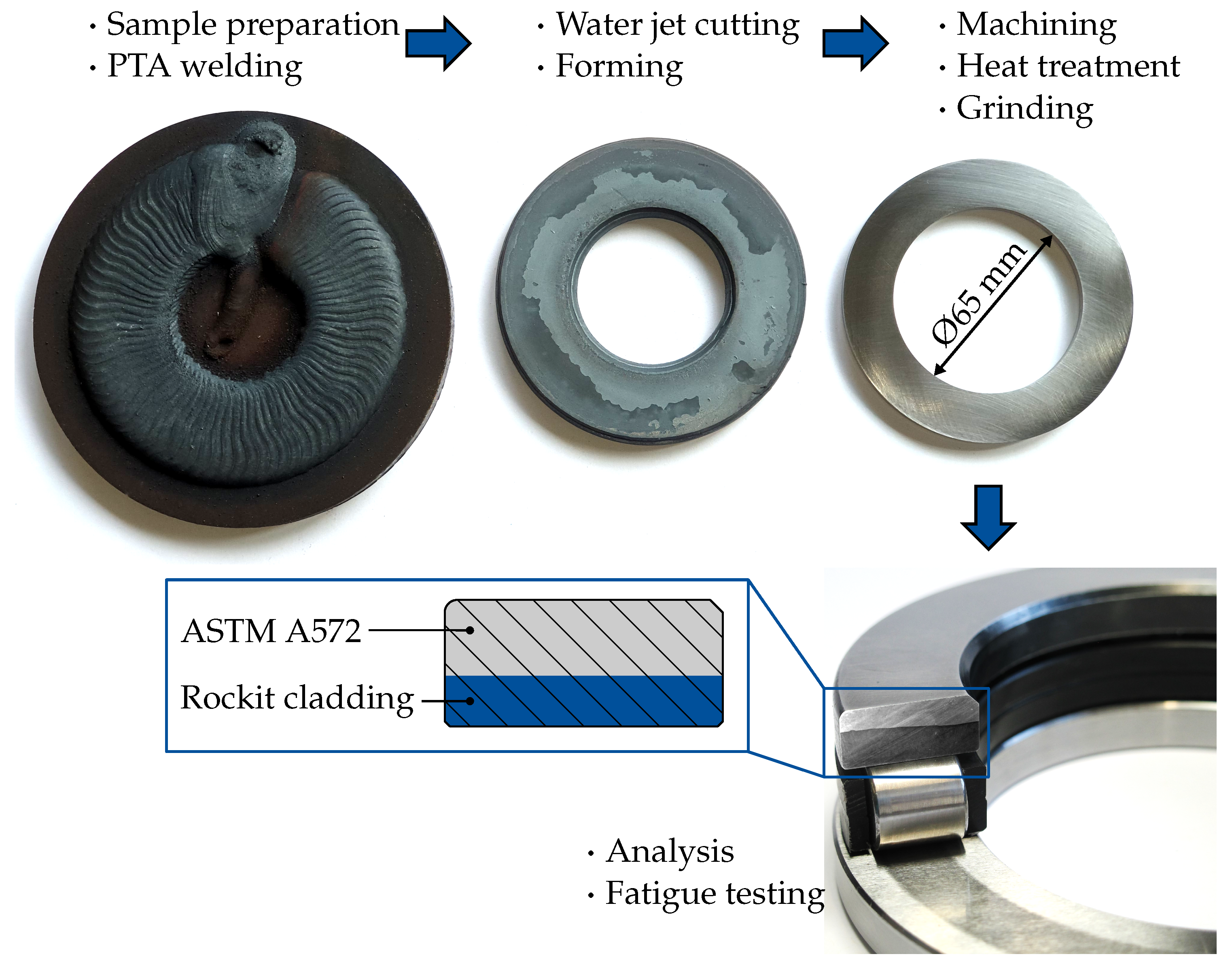
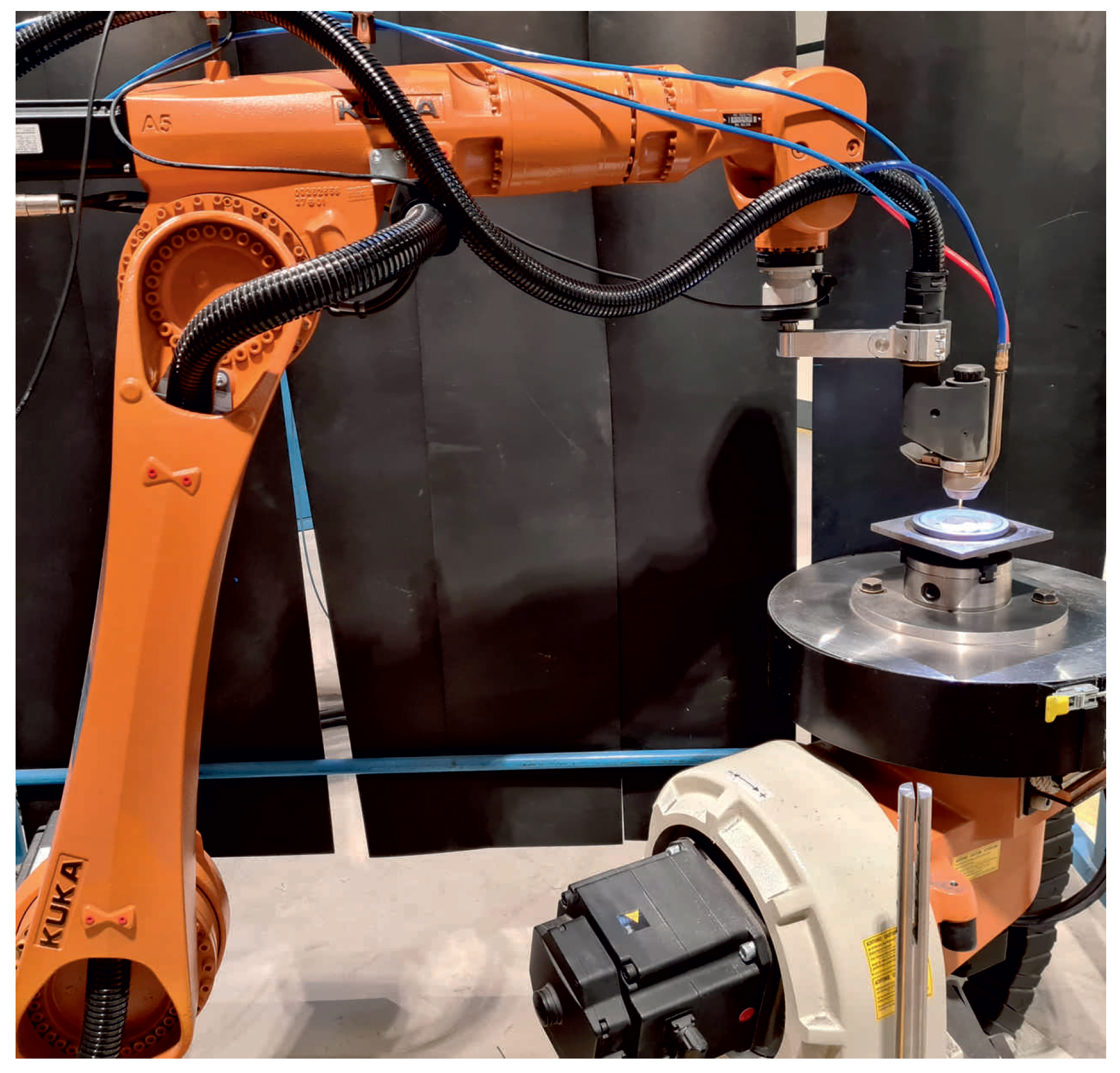


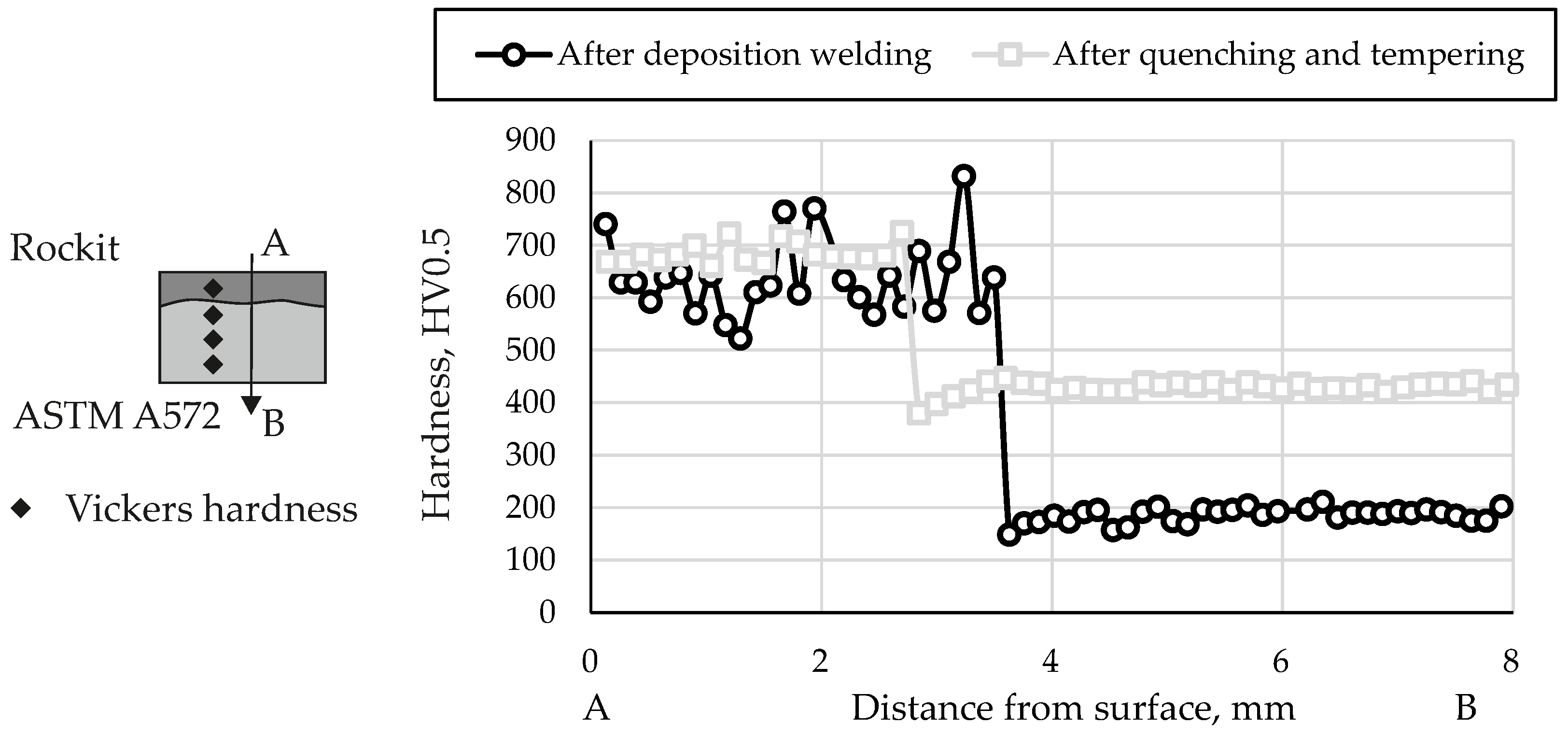
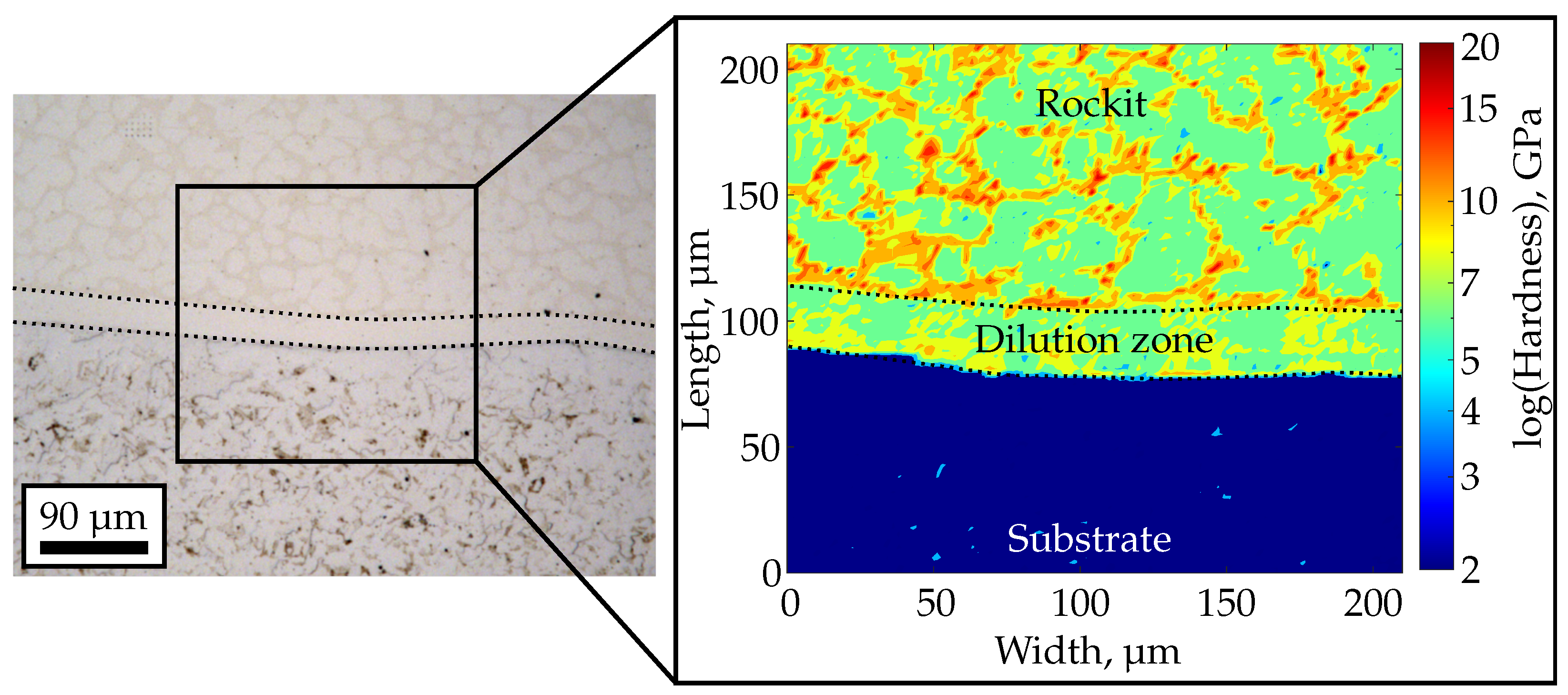
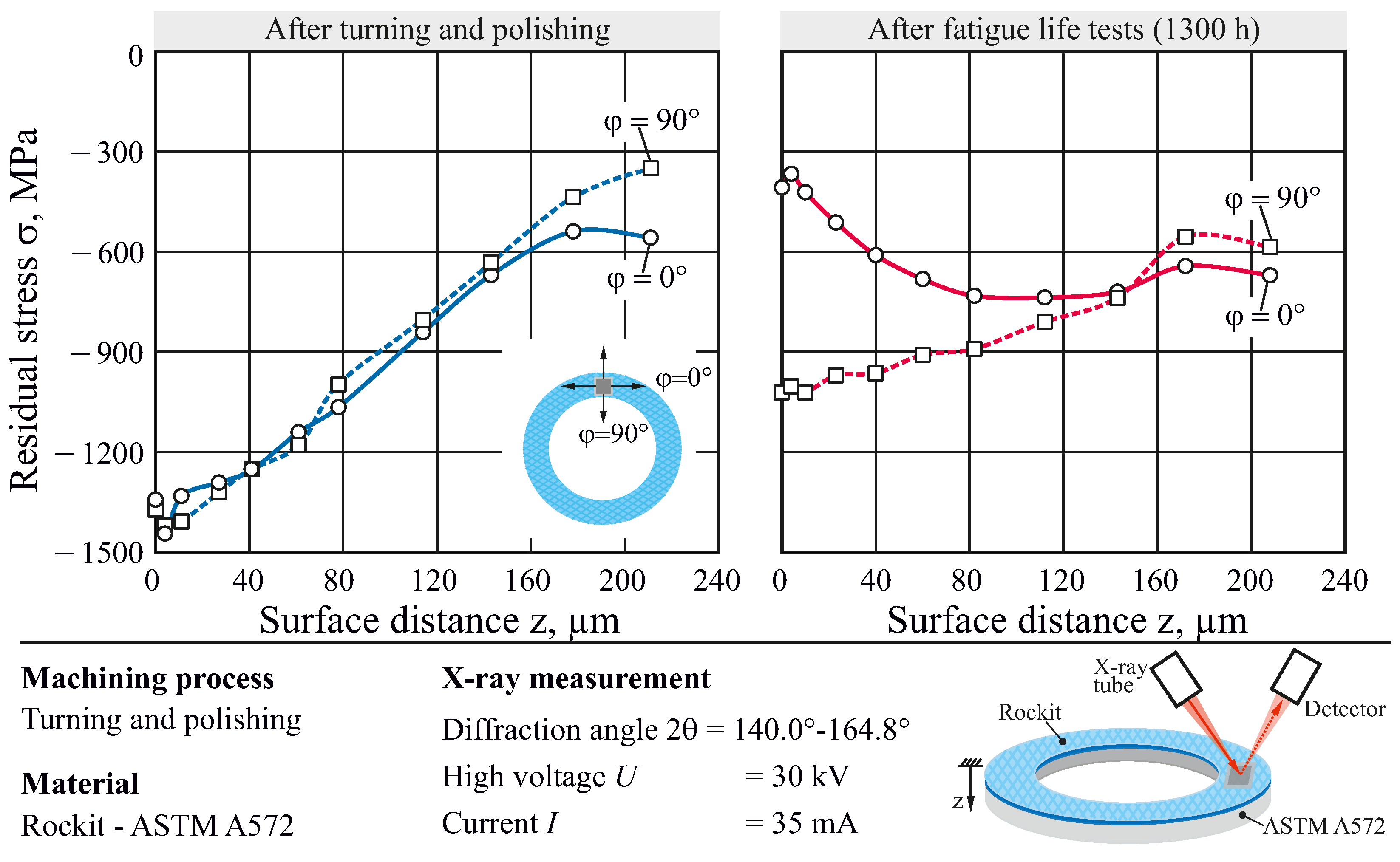
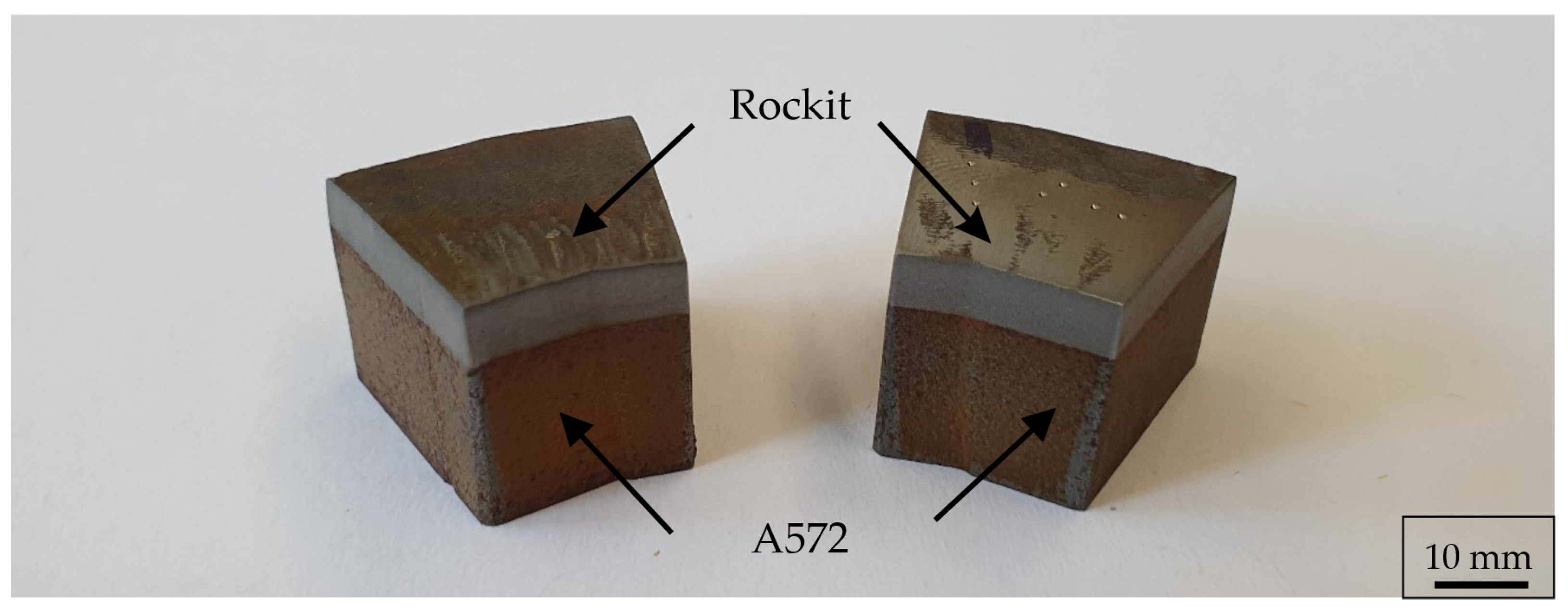
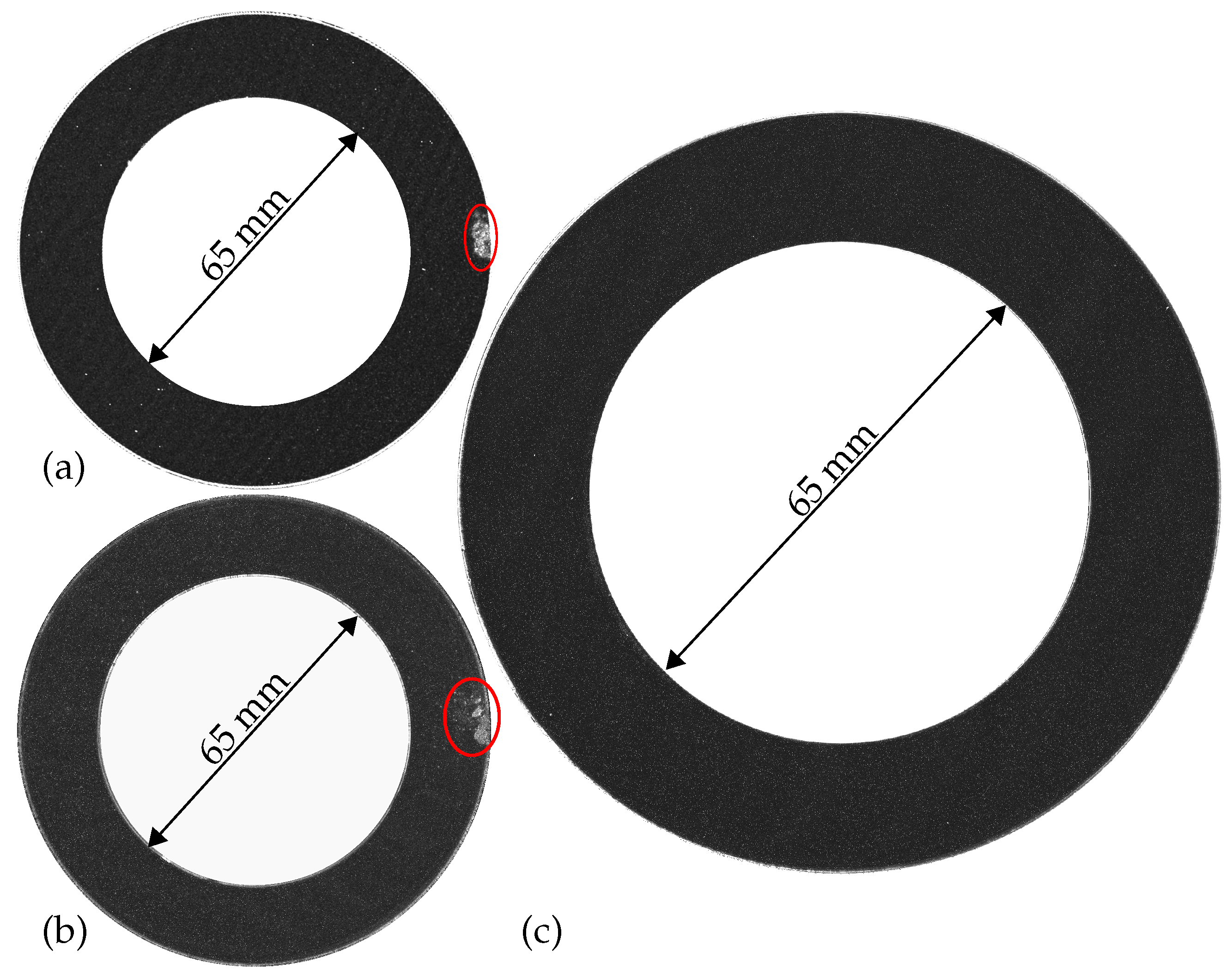
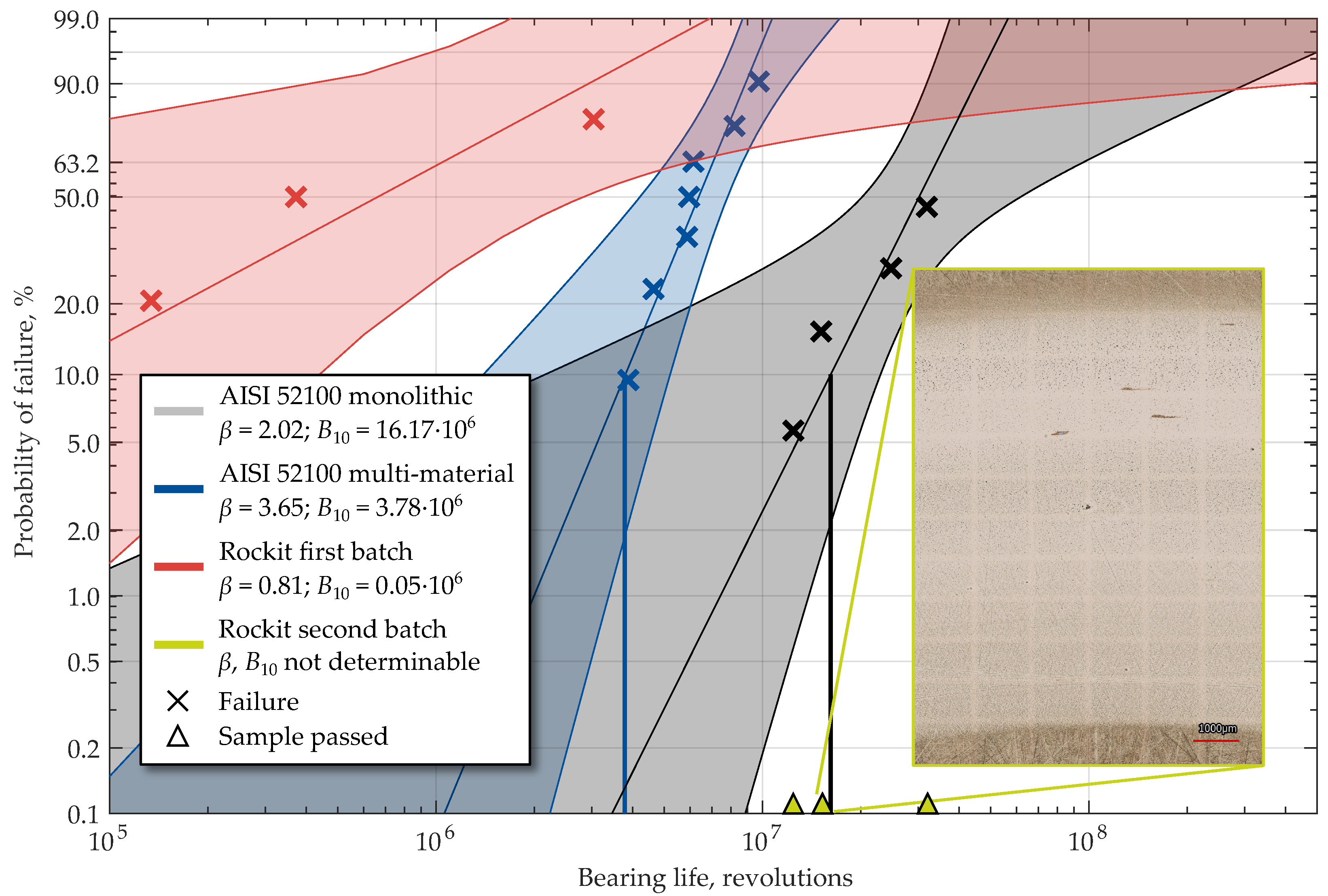
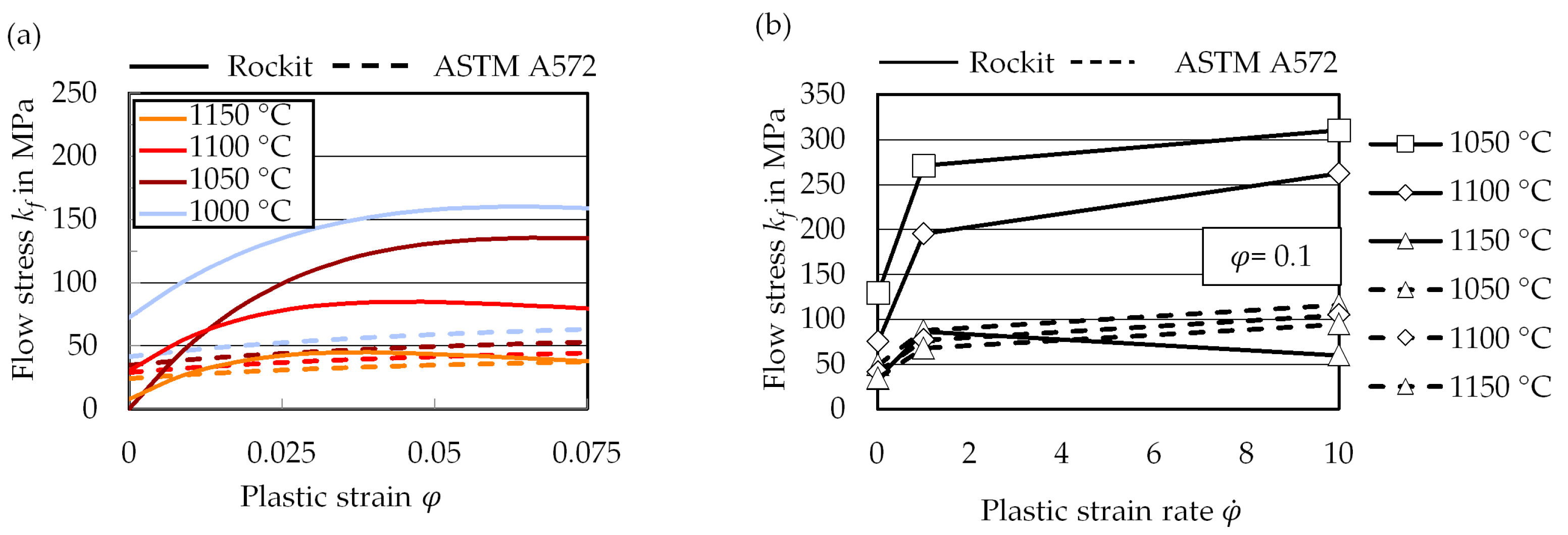
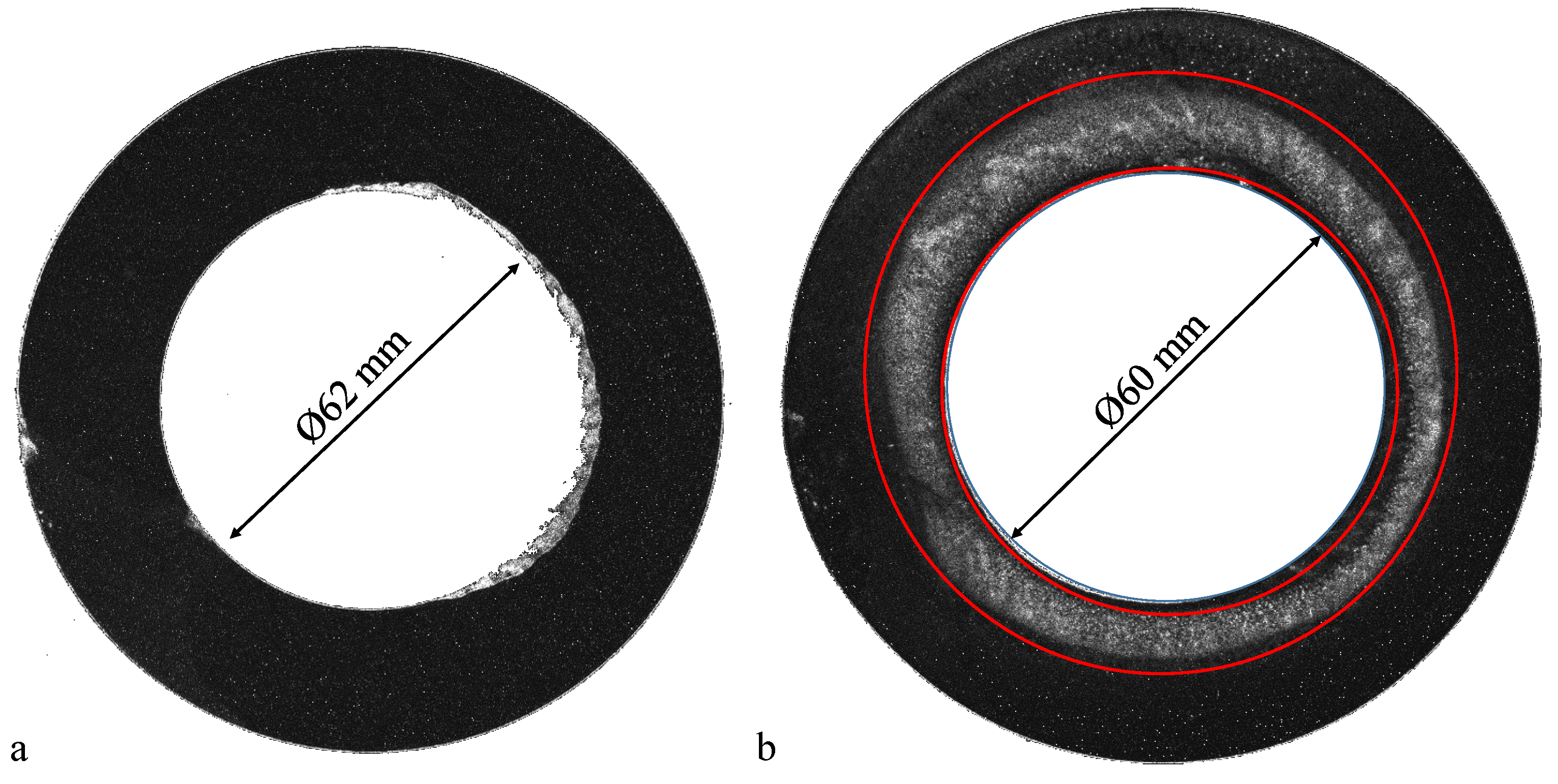
| Material | C | Si | Mn | Cr | Ni | Cu | V | Fe |
|---|---|---|---|---|---|---|---|---|
| ASTM A572 | 0.2 | 0.5 | 1.6 | - | - | 0.55 | - | bal. |
| Rockit® 401 | 0.15 | - | - | 18.39 | 2.4 | - | - | bal. |
| Rockit® 706 | 2.6 | 1.1 | - | 4.9 | 5.1 | - | 6.1 | bal. |
| Rockit® cladding | 0.54 | 0.24 | - | 15.73 | 1.92 | - | 1.22 | bal. |
| Parameter | Value |
|---|---|
| Current | 180–220 A |
| Voltage | 25–27 V |
| Welding speed (table) | 72°/min |
| Welding speed (torch) | 0.1 m/min |
| Oscillation frequency | 1 Hz |
| Amplitude | 3 mm |
| Transport gas flow (Argon) | 1.5 l/min |
| Plasma gas flow (Argon) | 1.3–1.6 l/min |
| Shielding gas flow (Argon) | 13 l/min |
| Particle size | 60–153 µm |
| Deposition rate | 12 kg/h |
| Loadstep | 1: Approval Testing | 2: Accelerated Life Tests |
|---|---|---|
| Rotational speed | 500 rpm for 24 h | 500 rpm until failure |
| Rotational speed | 750 rpm for 226 h | - |
| Axial load | 60 kN | 80 kN |
| Number of rolling elements | 19 | 15 |
| Hertzian pressure | 1.8 GPa | 2.2 GPa |
| Load ratio | 2.28 | 1.35 |
| Max. bearing temperature T | ≤86 °C | <99 °C |
| Viscosity ratio | 0.64 | 0.46 |
| Fatigue life L | 38.1 × 10 | 1.8 × 10 |
| Fatigue life L | 864 h | 60.3 h |
Publisher’s Note: MDPI stays neutral with regard to jurisdictional claims in published maps and institutional affiliations. |
© 2022 by the authors. Licensee MDPI, Basel, Switzerland. This article is an open access article distributed under the terms and conditions of the Creative Commons Attribution (CC BY) license (https://creativecommons.org/licenses/by/4.0/).
Share and Cite
Coors, T.; Faqiri, M.Y.; Saure, F.; Kahra, C.; Büdenbender, C.; Peddinghaus, J.; Prasanthan, V.; Pape, F.; Hassel, T.; Herbst, S.; et al. Investigations on Additively Manufactured Stainless Bearings. Coatings 2022, 12, 1699. https://doi.org/10.3390/coatings12111699
Coors T, Faqiri MY, Saure F, Kahra C, Büdenbender C, Peddinghaus J, Prasanthan V, Pape F, Hassel T, Herbst S, et al. Investigations on Additively Manufactured Stainless Bearings. Coatings. 2022; 12(11):1699. https://doi.org/10.3390/coatings12111699
Chicago/Turabian StyleCoors, Timm, Mohamad Yusuf Faqiri, Felix Saure, Christoph Kahra, Christoph Büdenbender, Julius Peddinghaus, Vannila Prasanthan, Florian Pape, Thomas Hassel, Sebastian Herbst, and et al. 2022. "Investigations on Additively Manufactured Stainless Bearings" Coatings 12, no. 11: 1699. https://doi.org/10.3390/coatings12111699
APA StyleCoors, T., Faqiri, M. Y., Saure, F., Kahra, C., Büdenbender, C., Peddinghaus, J., Prasanthan, V., Pape, F., Hassel, T., Herbst, S., Nürnberger, F., Wester, H., Uhe, J., Breidenstein, B., Denkena, B., Behrens, B.-A., Poll, G., & Maier, H. J. (2022). Investigations on Additively Manufactured Stainless Bearings. Coatings, 12(11), 1699. https://doi.org/10.3390/coatings12111699









